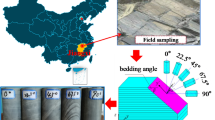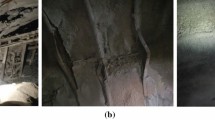Abstract
To study the anisotropic mechanical behaviour and creep characteristics of layered rock masses, this study conducts uniaxial compression and uniaxial compression creep tests on phyllite with bedding angles of 0°, 22.5°, 45°, 67.5° and 90°. Based on the energy calculation theory, the total strain energy, elastic energy and dissipated energy of rock samples under different loads are obtained. The results indicate that the total energy, elastic energy, dissipated energy and elastic energy ratio at the peak strength of the uniaxial compression stress–strain curve of the rock sample first decrease and subsequently increase with increasing bedding angle. The post-peak elastic energy mutation amplitude and dissipated energy mutation amplitude have the same trends. Thus, the bedding angle has a significant effect on the energy accumulation and dissipation of layered phyllite. In a uniaxial compression creep test, in addition to the first-stage loading, the total energy, elastic energy and dissipated energy of rock samples increase with increasing loading stress. At the peak point of the creep stress–strain curve, the total energy, elastic energy, dissipated energy, elastic energy ratio of the rock samples and the total energy absorbed by the rock samples under different loading stresses also first decrease and subsequently increase with increasing bedding angle, which indicates the anisotropic creep characteristics of the energy evolution of the layered rock mass. Compared with the uniaxial compression, the total energy of the layered rock mass under uniaxial creep stress increases by 1.13 ~ 1.91 times, and the dissipated energy increases by 2.44 ~ 8.18 times. Moreover, the failure mode of the rock sample produces more secondary cracks accompanied by local collapse. Based on these results, the influence of the anisotropic creep characteristics of layered rock masses on engineering cannot be ignored.











Similar content being viewed by others
References
Chen YJ, Fu YM, Cao P (2007) Structural effect of soft rock rheology. J Cent South Univ Technol 14(1):430–435. https://doi.org/10.1007/s11771-007-0299-2
Chen ZQ, He C, Ma GY, Xu GW, Ma CC (2019b) Energy damage evolution mechanism of rock and its application to brittleness evaluation. Rock Mech Rock Eng 52:1265–1274. https://doi.org/10.1007/s00603-018-1681-0
Chen ZQ, He C, Xu GW, Ma GY, Wu D (2019) A case study on the asymmetric deformation characteristics and mechanical behavior of deep–buried tunnel in phyllite. Rock Mech Rock Eng 52:4527–4545. https://doi.org/10.1007/s00603-019-01836-2
Dubey RK, Gairola VK (2008) Influence of structural anisotropy on creep of rocksalt from Simla Himalaya, India: an experimental approach. J Struct Geol 30(6):710–718. https://doi.org/10.1016/j.jsg.2008.01.007
Fu HL, Zhang JB, Huang Z, Shi Y, Chen W (2018) A statistical model for predicting the triaxial compressive strength of transversely isotropic rocks subjected to freeze–thaw cycling. Cold Reg Sci Technol 145:237–248. https://doi.org/10.1016/j.coldregions.2017.11.003
Gong FQ, Yan JY, Li XB, Luo S (2019a) A peak–strength strain energy storage index for rock burst proneness of rock materials. Int J Rock Mech Min Sci 117:76–89. https://doi.org/10.1016/j.ijrmms.2019.03.020
Gong FQ, Yan JY, Luo S, Li XB (2019b) Investigation on the linear energy storage and dissipation laws of rock materials under uniaxial compression. Rock Mechanics and Rock Engineering 52: 4237–4255, https://doi.org/10.1007/s00603-019-01842-4
Han C, Pang DP, Li DJ (2020) Analysis of energy evolution during the step loading and unloading creep experiments of sandstone. Chin J Rock Soil Mech 41:1179–1188. https://doi.org/10.16285/j.rsm.2019.0872
ISRM (2007) The complete ISRM suggested methods for rock characterization, testing and monitoring: 1974–2006. In: Ulusay R, Hudson JA (eds) Suggested methods prepared by the commission on testing methods. International Society for Rock Mechanics, Compilation Arranged by the ISRM Turkish National Group, Ankara, Turkey, pp 628
Li XC, Yang CL, Ren T, Nie BS, Zhao CH, Liu SW, Jiang T (2017) Creep behaviour and constitutive model of coal filled with gas. Int J Min Sci Technol 27:847–851. https://doi.org/10.1016/j.ijmst.2017.07.017
Li CB, Bažant ZP, Xie HP, Rahimi-Aghdam S (2019) Anisotropic microplane constitutive model for coupling creep and damage in layered geomaterials such as gas or oil shale. Int J Rock Mech Min Sci 124:104074. https://doi.org/10.1016/j.ijrmms.2019.104074
Liu ZB, Xie SY, Shao JF, Conil N (2015) Effects of deviatoric stress and structural anisotropy on compressive creep behavior of a clayey rock. Appl Clay Sci 114:491–496. https://doi.org/10.1016/j.clay.2015.06.039
Liu X, Li S, Zhou Y, Li Y, Wang W (2020) Study on creep behavior and long–term strength of argillaceous siltstone under high stresses. Chinese Journal of Rock Mechanics and Engineering 39(1): 138–146 (in Chinese with English abstract), https://doi.org/10.13722/j.cnki.jrme.2019.0279
Peng RD, Ju Y, Wang JG, Xie HP, Gao F, Mao LT (2015) Energy dissipation and release during coal failure under conventional triaxial compression. Rock Mech Rock Eng 48:509–526. https://doi.org/10.1007/s00603-014-0602-0
Reza Taheri S, Pak A, Shad S, Mehrgini B, Razifar M (2020) Investigation of rock salt layer creep and its effects on casing collapse. Int J Min Sci Technol 30:357–365. https://doi.org/10.1016/j.ijmst.2020.02.001
Shen PW, Tang HM, Zhang BC, Ning YB, He C (2021) Investigation on the fracture and mechanical behaviors of simulated transversely isotropic rock made of two interbedded materials. Eng Geol 286:106058. https://doi.org/10.1016/j.enggeo.2021.106058
Wang ZW, Qiao CS, Song CY, Xu JF (2014) Upper bound limit analysis of support pressures of shallow tunnels in layered jointed rock strata. Tunn Undergr Space Technol 43:171–183. https://doi.org/10.1016/j.tust.2014.05.010
Xie HP, Ju Y, Li LY. (2005) Criteria for strength and structural failure of rocks bases on energy dissipation and energy release principles. Chinese Journal of Rock Mechanics and Engineering 24: 2603–2608, 1000-6915(2005)17-3003-08
Xie HP, Li LY, Peng RD, Ju Y (2009) Energy analysis and criteria for structural failure of rocks. J Rock Mech Geotech Eng 1:11–20. https://doi.org/10.3724/SP.J.1235.2009.00011
Xu GW, He C, Su A, Chen ZQ (2018) Experimental investigation of the anisotropic mechanical behavior of phyllite under triaxial compression. Int J Rock Mech Min Sci 104:100–112. https://doi.org/10.1016/j.ijrmms.2018.02.017
Xu GW, He C, Chen ZQ, Yang QH (2020) Transversely isotropic creep behavior of phyllite and its influence on the long–term safety of the secondary lining of tunnels. Eng Geol 278:105834. https://doi.org/10.1016/j.enggeo.2020.105834
Yang SQ, Yin PF, Huang YH, Cheng JL (2021) Strength, deformability and X-ray micro-CT observations of transversely isotropic composite rock under different confining pressures. Eng Fract Mech 241:107389. https://doi.org/10.1016/j.engfracmech.2019.04.030
Zhang Q, Yang W, Chen F, Li W, Wang J (2011) Long–term strength and microscopic failure mechanism of hard brittle rocks. Chin J Geotech Eng 33(12):1910–1918 ((in Chinese with English abstract))
Zhang JB, Fu HL, Huang Z, Wu YM, Chen W, Shi Y (2019a) Experimental study on the tensile strength and failure characteristics of transversely isotropic rocks after freeze–thaw cycles. Cold Reg Sci Technol 163:68–77. https://doi.org/10.1016/j.coldregions.2019.04.006
Zhang XM, Ou XF, Gong FQ, Yang JS (2019b) Effects of bedding on the dynamic compressive properties of low anisotropy slate. Rock Mechanics Rock Engineering 52(4):981–990. https://doi.org/10.1007/s00603-018-1638-3
Zhao K, Ma HL, Yang CH, Chen XS, Liu YB, Liang XP, Cai R (2021) Damage evolution and deformation of rock salt under creep–fatigue loading. Rock Mech Rock Eng 54:1985–1997. https://doi.org/10.1007/s00603-020-02342-6
Zhao K, Yu X, Zhou Y, Wang Q, Wang JQ, Hao JL (2020) Energy evolution of brittle granite under different loading rates. Int J Rock Mech Min Sci 132:104392. https://doi.org/10.1016/j.ijrmms.2020.104392
Zhou YQ, Sheng Q, Li NN, Fu XD (2020) The influence of strain rate on the energy characteristics and damage evolution of rock materials under dynamic uniaxial compression. Rock Mech Rock Eng 53:3823–3834. https://doi.org/10.1007/s00603-020-02128-w
Acknowledgements
The authors also express special thanks to the editors and anonymous reviewers for their constructive comments.
Funding
This study was financially supported by the National Natural Science Foundation of China (grant nos. 51978668 and 52108367) and the Innovation Project of Guangxi Graduate Education (grant no. YCSW2021021).
Author information
Authors and Affiliations
Corresponding author
Ethics declarations
Conflict of interest
The authors declare no competing interests.
Additional information
Responsible Editor: Zeynal Abiddin Erguler
Rights and permissions
About this article
Cite this article
Zhang, J., Zhang, X., Huang, Z. et al. Energy evolution mechanism of the mechanical and creep properties of layered phyllite under uniaxial compression and creep tests. Arab J Geosci 14, 2437 (2021). https://doi.org/10.1007/s12517-021-08757-x
Received:
Accepted:
Published:
DOI: https://doi.org/10.1007/s12517-021-08757-x




